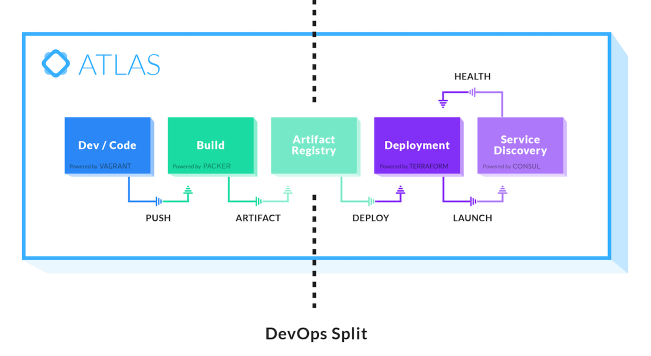
After releasing five popular open-source technologies, HashiCorp is tying them all together with Atlas—a commercial DevOps and application-delivery product for developing, deploying, and maintaining applications on any infrastructure.
Described in HashiCorp’s news release as an AWS-style application delivery SaaS for any public or private data center, Atlas unifies the company’s open-source projects (Vagrant, Packer, Serf, Consul and Terraform) in a single dashboard and workflow. Through Atlas, both open-source users and enterprises can manage servers, containers, virtual machines, configuration management and more on any system. For every application, developers or operators define the IDE, the deployment description and the code artifact.
(Related: Working with DevOps)
HashiCorp’s CEO Mitchell Hashimoto sees Atlas as a way for enterprises to keep up with the curve of unifying new DevOps tools within an organization. A company that sees promise in what a new tool is offering but is already invested in other tools, he explained, can experiment with new tools without compromising its workflow.
“Atlas is really the universal answer to application delivery and DevOps in general,” said Hashimoto. “It’s the idea that you can work at the workflow level on these high-level problems of development, building, deployment and scaling. The goal…since back [when] we started our open-source projects was really to make deployment and application delivery something that companies just do, and don’t have to dedicate resources to figuring out how to do.”
As with Vagrant and HashiCorp’s other open-source projects, Atlas is technology-agnostic. For DevOps teams, this means they can configure and deploy an application on cloud platforms such as AWS, CoreOS Rocket, DigitalOcean, Docker, Google’s Compute Engine, Heroku, OpenStack, VMware or a combination of platforms.
“Most organizations we talk to today just have a mix of everything,” Hashimoto said. “I’ve never talked to a single company greater than maybe five people that have just one homogenous set of technologies. Typically there’s maybe some Chef, maybe some Puppet, maybe some Docker, maybe just some pure AWS. It’s a mix, so we’re trying to solve it at that layer.”
The release of Atlas is a milestone for HashiCorp. Along with Atlas, the company today announced US$10 million in Series A funding, which according to Hashimoto will be used to commercialize Atlas while continuing to support its open-source projects.
What began as a college distributed deployment project between Hashimoto and HashiCorp cofounder Armon Dadgar ultimately evolved into the release of Vagrant in 2010, followed by the founding of HashiCorp in 2012 and the company’s other core open-source projects.
“Through Atlas being a commercial piece of software, it uses open source for so much and allows us to really continue to focus and love the open-source community we’ve built, rather than risking fragmentation,” Hashimoto said. “Throughout every feature, the open-source technologies are integral. For developers, Vagrant is in use. For artifacts, Packer is in use. For the deployment, Terraform is in use. And for the monitoring, Consul is in use.”
Open source is tied into every facet of the product, but Atlas is designed to be both familiar to open-source users and streamlined for enterprises. According to Hashimoto, most current open-source and commercial projects in the space focus on narrow technologies, such as VMware’s platform-specific vSphere. To prevent organizations from having to build custom deployment solutions to fill the void, one of Atlas’ main goals is universal applicability.
“We’ve always wanted to make something you don’t have to worry about, so you can just focus as a company on what you want to do best,” Hashimoto said. “You can focus more on shipping your applications if you’re a software developer. You can focus more on building cars if you’re a carmaker. Application delivery should be a click-button easy thing that just happens. It shouldn’t be a whole process you have to be a professional at to understand. The idea that by breaking down application delivery into these high-level build/deploy/maintain kind of components, you can solve it at that higher level without becoming an expert in every system to do it.”
A beta version of Atlas is available today, with a full product release coming in early 2015. Beyond the initial release, Hashimoto revealed plans to focus on “some of the more magical-feeling features,” including auto-scaling, self-healing, early detection and a set of templates, with a goal of simplifying migration between cloud providers. On the open-source side, HashiCorp is working on implementing more collaboration features in Vagrant and adding more-complicated orchestration and rolling deploys to Terraform, and those will feed into Atlas.
“Because the core of Atlas is open source, as we add features to open source we’re inherently adding features to Atlas, which is a really great symbiotic relationship,” Hashimoto said. “We’re not taking advantage of open source with an open core or anything like that, and the open-source [community] gets access to all these features for free. Some may have believed we solve problems randomly, but the purpose of Atlas is to show that these separate open-source components are designed to integrate really well together. We’ve done the work to integrate them for you as a commercial solution. There was a plan this entire time to head in this direction.”






